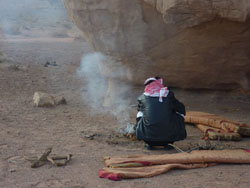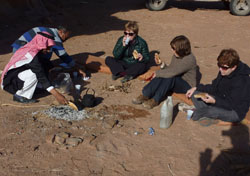Jordanian Trio
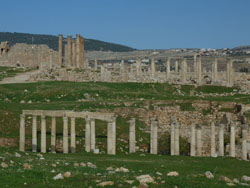
Jordan has a wealth of historical/archeological/biblical sites and natural beauty, but the top three sites would have to be the ruins of the Roman city at Jerash, the famed carved tombs of Petra, and the incredible vast landscapes of Wadi Rum.
North of the capital of Amman the route winds through a series of fairly steep ravines and hillsides--most of which are covered in agricultural plots and groves of olive and fruit trees--the market garden of Jordan. Its pretty countryside in a stark way--reddish earth and hillsides, stands of pines and scrub, rock terraces and groves of olives and fruit trees. Further north, the vegetable fields give way to hillsides covered in all directions in olives and pines. The occasional hill town is a jumbled collection of boxy white concrete and stone flat roofed houses.
The unquestioned historical gem of northern Jordan is Jerash (or Gerasa originally) an immense ruin/remain of a Roman town which rose to prominence in Alexandrian times (333 BC) and whose heyday was the first century AD when a new city plan was executed under the emperor Trajan. Jerash contains a small, but one of the best preserved amphitheatres we've ever seen. There is a very interesting acoustic focal point where one can stand and orating toward the seats, an amplified, stereophonic echo rebounds everywhere. For two weeks each summer the Jerash Festival, started two decades ago by then Queen Noor to benefit her cultural foundation, brings all manner of music, dance and theater to the site, day and night.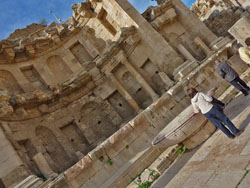
There are a trio of Christian churches side by side: St George, St john the Baptist and St Cosmos, with a few remaining mosaic floors. The Temple of Zeus with its enormous pillars, many still standing due to the mortar-less construction method that renders them somewhat flexible, sits on a commanding hill overlooking the Temple of Diana and the Agora--the open marketplace surrounded by stone stalls. The enormous oval colonnaded Forum is connected by a kilometer of Roman road --the cardo maximus--that runs from the north to the south gate. It's paved in huge stones--once perfectly flat, but now quite undulating from intervening earthquakes. At its center, flanked by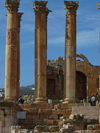 four ornamental tetrapylons, is the intersection with the east-west road, the south decumanus, its colonnades stretching to the western baths. At the site's far south sits Hadrian's Triumphal Arch, and the Hippodrome, in which are staged re-enactments of gladiator battles, chariot races, and a Roman Legion marching in formation. Jerash really like seeing the entire Forum in Rome spread across a plateau far-flung in the empire.
four ornamental tetrapylons, is the intersection with the east-west road, the south decumanus, its colonnades stretching to the western baths. At the site's far south sits Hadrian's Triumphal Arch, and the Hippodrome, in which are staged re-enactments of gladiator battles, chariot races, and a Roman Legion marching in formation. Jerash really like seeing the entire Forum in Rome spread across a plateau far-flung in the empire.
The crown jewel in the Jordanian panoply of sites is undoubtedly Petra, in the southwest—just 30 miles or so from the Israeli border. The ancient city was first constructed by the Nabataeans, and later came under Roman rule. Earthquake and flooding had destroyed much of the city and it remained obscure for centuries until rediscovered by Swiss explorer Johann Ludwig Burckhardt (who came to be known as 'Ibrahim' Burckhardt) in 1812. The site 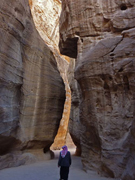 became a UNESCO World Heritage site in 1985, and was made even more famous by the third Indiana Jones movie, The Last Crusade, with its horseback chase through the narrow winding stone Siq--the canyon that leads to the astonishing carved tombs contained in the site.
became a UNESCO World Heritage site in 1985, and was made even more famous by the third Indiana Jones movie, The Last Crusade, with its horseback chase through the narrow winding stone Siq--the canyon that leads to the astonishing carved tombs contained in the site.
It takes a full day to even get an overview of the site, and you could easily spend several days exploring, if architecturally and historically inclined. The tombs were constructed around 2000 years ago by the Nabateans, who were a nomadic tribe originating in Saudi Arabia. One twists and winds 1.2 km gently down the narrow Siq, its towering eroded multi-hued stone walls undulating on both sides. The narrowest parts are said to be 'only the width of a camel'. There are small niches and tombs carved in the walls of the Siq. The Treasury is the first major tomb encountered, and probably the most iconic of all, glimpsed first as a gleaming sliver just visible between the walls round the final bend in the Siq. One then emerges 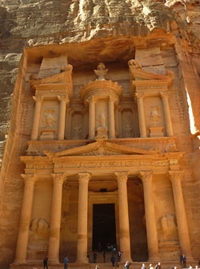 directly under its full glory: two towering stories of doric columns, double pediment, stone lions and horses carved deep into the glowing red-gold sandstone of the cliffs. Another two winding kilometers passes the curving open-air theatre set into the cliff, a series of ornate tombs carved higher up the stone cliffs, known collectively as the Royal Tombs, the Great Temple, built by the Nabateans in the first century BC and only uncovered in 1993 by a Brown University team, and the colonnade-lined Roman road, which was built by the Romans 100 years AD over an earlier Nabatean thoroughfare. High up in the cliffs, up a thousand stairs, is Al-Deir, originally a tomb for King Obodas I, which is similar to and even more massive than the Treasury. It is also called the Monastery, for crosses carved in it’s inside walls--perhaps indicating its use as a Byzantine church at one point.
directly under its full glory: two towering stories of doric columns, double pediment, stone lions and horses carved deep into the glowing red-gold sandstone of the cliffs. Another two winding kilometers passes the curving open-air theatre set into the cliff, a series of ornate tombs carved higher up the stone cliffs, known collectively as the Royal Tombs, the Great Temple, built by the Nabateans in the first century BC and only uncovered in 1993 by a Brown University team, and the colonnade-lined Roman road, which was built by the Romans 100 years AD over an earlier Nabatean thoroughfare. High up in the cliffs, up a thousand stairs, is Al-Deir, originally a tomb for King Obodas I, which is similar to and even more massive than the Treasury. It is also called the Monastery, for crosses carved in it’s inside walls--perhaps indicating its use as a Byzantine church at one point.
Admittedly Petra is overly crowded, with too many tourists, souvenir vendors and purveyors of camel and donkey rides for those too weary to make the 4 km trek back out from the end, but it is still absolutely breathtaking, stunning, and glorious. There is something about the enormity, the lustrous colors of stone combined with the freshness of carving (resulting from the protecting overhangs of cliffs that were left by the builders) that simply leaves the viewer jaw-dropped and slack-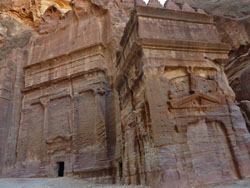 mouthed.
mouthed.
If Petra is a crown jewel, then Wadi Rum must be at least a diadem. At the far south of Jordan towering mounts of eroded sandstone and granite rise out of the flat expanse of the southern desert, covering roughly 700 square kilometers. Strewn across miles of sand are flat-topped buttes, finger-spires known as jebels, gnarled shapes pocked with deep clefts, and layer cakes of sandstone looking as though they are dripping with rain-eroded caramel rock icing. There are vast stretches of golden desert, steep drifts of rust-red sand piling up against 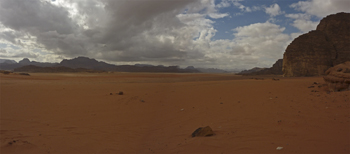 black and tan turrets of stone. T E Lawrence called Wadi Rum "vast, echoing and god-like". This wild expanse was a favorite place of the late King Hussein, who liked to ride his Harley across these vast desert scapes--his son Abdullah, the current King reportedly occasionally follows suit.
black and tan turrets of stone. T E Lawrence called Wadi Rum "vast, echoing and god-like". This wild expanse was a favorite place of the late King Hussein, who liked to ride his Harley across these vast desert scapes--his son Abdullah, the current King reportedly occasionally follows suit.
The day of our visit was cool and windy, with dramatic cumulus clouds piling up on top of the stone castles occasionally letting shafts of warming sunlight through. We headed out into the desert in the back of a red four-wheel drive piloted by our Bedouin Huweitat-tribe guide Abu Hamseh. He was in great spirits, and ululated to the wind and stone as we careened across the expanses separating the rock valleys to visit the spire known as Mushroom Rock (guess!), the cave once inhabited by Lawrence of Arabia as he fought the Ottomans during the Arab Revolt of 1917–18, and the enormous twisted formation named by Lawrence the Seven Pillars of Wisdom. We passed the occasional dark, striped goat-hair Bedouin tent nestled at the foot of a mount, a small herd of goats milling nearby, illustrating how incredibly sparsely populated the area is.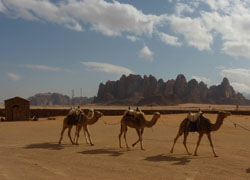
Abu pulled into the lee of an overhanging cliff, gathered an armload of dry branches, and lit a fire into which he set a dented and blackened tea-kettle. When the kettle boils it's set aside to cool, and rounds of flatbread are thrown onto the coals to heat. Each hot circle gets a couple chunks of soft cheese placed into it before being folded over, and so sitting around the fire this miniscule tribe of travelers devoured a Bedouin lunch of smoky cheese sandwiches and desert tea--sweet tea flavored with thyme, sage and wood smoke--surrounded by one of the most fantastic vistas in the world.
